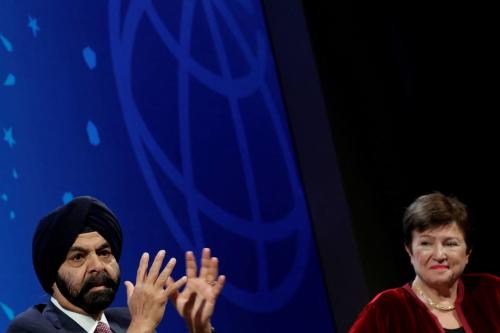In July of this year, Ethiopia will host a global conference to discuss how to finance the forthcoming Sustainable Development Goals (SDGs). Yet when I visited Addis Ababa in January, and in many conversations since, most Ethiopians officials and activists weren’t talking about this. They were focused on domestic economics and politics. The Ethiopian government is prioritizing economic growth, because the country wants to become a middle-income economy in 10 years. Activists want political space to hold their government accountable. With May 2015 elections approaching, why would Prime Minister Haile Mariam pledge in July to spend precious domestic resources on meeting the health, education, inequality, or climate SDGs? When his current growth strategy is already attracting investors and public acclaim, why would he commit his country in September to an SDG goal on economic growth?
Most finance ministers in Washington this week will ask much the same question: what is the political or economic value of translating their national fiscal policies into public commitments to finance the SDGs in their own countries? If the answer is “not much,” we can expect their April skepticism to silence any national-level commitments in Addis in July.
The international public finance community knows this, and is getting nervous. Addis will be rated a failure if we get neither a big global deal nor a patchwork of country-level commitments that collectively feel like a new fiscal conversation. A big deal is still possible—an agreement to regulate taxes globally may happen; or donors might agree to channel 50 percent of total aid flows to least developed countries (Ireland is the only country that does that now). We might even see blended spending commitments on essential services of at least $300 per person per year, as Brookings scholars Homi Kharas and John McArthur propose.
But we should be spending more time answering a second question: what public financing tools might make it more politically compelling to the world’s finance ministers to commit their own domestic resources to the SDGs?
I believe one answer is results based financing, in a different guise than “structural adjustment,” which imposed the Washington Consensus in lockstep fashion on mostly unwilling governments.
A new generation of investment financing focuses more on “results”—rewarding governments for achieving their declared priorities—without dictating exactly what those priorities should be or how they are achieved.
Already, some of those approaches are delivering remarkable results domestically in the United States and internationally, and are reshaping multilateral, bilateral, and private financing:
- Multilateral. The World Bank’s first new funding instrument in 30 years, the Program for Results, operates in this way and has already programmed $2.5 billion dollars, supporting $5.5 billion in government programs. PforR confronts the false choice between strengthening local institutions and achieving lasting results by investing through those institutions and disbursing upon delivery. It operates at the kind of scale in some countries that could change the calculus as to whether a government will commit to an SDG target as a PforR outcome.
- Bilateral. Government-to-government Results Based Aid (“RBA”) also offers an avenue to incentivize countries to make specific SDG commitments. Perakis and Savedoff look at interesting examples of RBA, which could easily be translated into SDG goals. The successor to GAVI, (the Health System Strengthening Program) could reward a government for committing to SDG target 3.8 (on universal health coverage). DFID funding in in Ethiopia could incentivize that government to commit to SDG target 4.1 (on primary and secondary education). Norway could use the same approach it took with the Amazon Fund in Brazil to challenge Liberia, Peru, or Indonesia to meet SDG target 15.2 by 2020 (on forestation).
- Private Flows. Development Impact Bonds (or “DIBs,” a type of social impact bond) offer a way for private investors to get involved in the SDGs. DIBs allow private investors to agree on an SDG-related target or outcome with a government and then get their money back plus a return if the target is achieved. There is not a lot of money in DIBS, but as Homi Kharas and ODI co-authors argue, we need to start recognizing these kinds of financing guarantees and we need basic international metrics for private finance for development.
Results based financing is not only easier to sell to domestic audiences of donors and investors (“we’re paying for results not waste”), but is more politically palatable for recipients (“we decide how to deliver”), and critically, privileges transactions between “developcrats” on both sides to ensure money is not wasted by short-sighted political operators with non-development priorities in mind.
As the SDGs and new financing arrangements emerge, results based financing will get more traction for three reasons: it reflects a political evolution in the fight against poverty by shifting power and accountability to the governments that should be first responders; it aims to deliver results and strengthen the local institutions that will have to manage and spend their own resources in the long-term; and with technology and costs shifting rapidly, it offers real potential for citizens to hold their own governments accountable on what they really care about—results!
If any finance minister does make a commitment in Addis to achieve an SDG outcome and can’t achieve that goal with domestic resources alone, I will wager that any public international finance they get will come in the form of results based financing.



Commentary
Catalyzing SDG financing by transferring the power
April 17, 2015